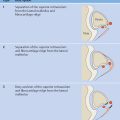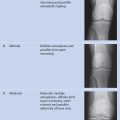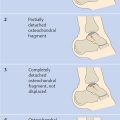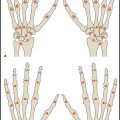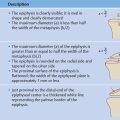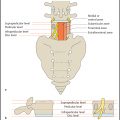Musculoskeletal Tumors
Histopathologic Classification
The World Health Organization (WHO) published a revised version of the histopathologic classification of bone and soft-tissue tumors in 2002.
Bone Tumors
Bone tumors are classified either by their tissue of origin (e.g., cartilage and osteogenic tumors) or by their characteristic cell type (e.g., giant cell tumor) ( Table 10.1 ). Exceptions are tumors of the Ewing group and “miscellaneous tumors” whose origin is uncertain. The classification also includes miscellaneous tumorlike (nonneoplastic) lesions, omitting some typical entities in this category such as nonossifying fibroma. Synovial osteochondromatosis is listed as a joint lesion that, although it may cause secondary bone involvement, primarily represents a soft-tissue process.
Soft-Tissue Tumors
The WHO classification of soft-tissue tumors ( Table 10.2 ) lists more than 120 different entities in its original version, including many rare lesions and subtypes. The tumors are classified on the basis of histologic differentiation and are divided into benign, intermediate, and malignant subgroups. Intermediate lesions are benign tumors with locally aggressive behavior such as desmoid-type fibromatosis or low-grade malignancies such as well-differentiated liposarcoma. The classification also includes soft-tissue tumors of unknown origin. Neurogenic soft-tissue tumors have been disregarded in the WHO classification of soft-tissue tumors because they are classified as tumors of neural origin. Entities in this category that are relevant to soft-tissue imaging were adopted from Enzinger and Weiss and added to Table 10.2 .
Fletcher CDM, Unni KK, Mertens F, eds. Pathology and genetics of tumours of soft tissue and bone. In: World Health Organization Classification of Tumours. Lyon: IARC Press; 2002 Weiss SW, Goldblum JR, eds. Enzinger and Weiss′s Soft Tissue Tumors. 4th ed. St. Louis: Mosby; 2001Staging
Staging of Malignant Bone Tumors
In Europe the clinical staging of a malignant bone tumor is usually based on the classification of the American Joint Committee on Cancer (AJCC) adopted by the Union internationale contre le cancer (UICC) ( Table 10.3 ). This is a TNM system that has been expanded by adding the grade of histologic tumor differentiation (G), which is a key determinant of prognosis. Only the tumor diameter (T1/T2) and the presence of skip lesions (T3) are relevant for describing local tumor extent. Skip lesions, which are bony metastases occurring in the same bone as the primary tumor, are best detected or excluded by magnetic resonance imaging (T1-weighted spin-echo sequence). Regional lymph node metastases (N1) are very rare with bone tumors. Distant metastasis occurs predominantly to the lung (M1a) and rarely to other organs (M1b).
Staging of Soft-Tissue Sarcomas
As far as local tumor extent is concerned, the staging system for soft-tissue sarcomas ( Table 10.4 ) differs only in its designation of tumor size (T1/T2) and lesion location relative to the muscle fascia (a/b). Superficial tumors are subcutaneous lesions that are entirely superficial to the muscle fascia and show no fascial invasion. Deep tumors may be entirely beneath the fascia, above the fascia and invading it, or both above and beneath the fascia. Retroperitoneal, mediastinal, and pelvic soft-tissue sarcomas are classified as deep tumors.
Lymph node metastases (N1) are rare with soft-tissue sarcomas. Distant metastasis (M1) occurs predominantly to the lung.
Classification | |
Cartilage tumors
| |
Osteogenic tumors
| |
Fibrogenic tumors
| |
Fibrohistiocytic tumors
| |
Ewing sarcoma and PNET
| |
Hematopoietic tumors
| |
Giant cell tumor
| |
Notochordal tumors
| |
Vascular tumors
| |
Smooth muscle tumors
| |
Lipogenic tumors
| |
Neural tumors
| |
Miscellaneous tumors
| |
Miscellaneous/Tumorlike lesions
| |
Joint lesions
| |
NOS = Not otherwise specified PNET = Primitive neuro-ectodermal tumor | |
Classification |
Adipocytic tumors Benign • Lipoma and variants Intermediate Well-differentiated liposarcoma Malignant Liposarcoma (subtypes) |
Fibroblastic and myofibroblastic tumors Benign • Nodular fasciitis • Proliferative fasciitis • Proliferative myositis • Myositis ossificans • Ischemic fasciitis • Elastofibroma • Fibrous hamartoma • Fibromatosis (subtypes) • Fibroma, fibroblastoma (subtypes) Intermediate (locally aggressive) • Superficial fibromatosis • Desmoid-type fibromatosis • Lipofibromatosis Intermediate (rarely metastasizing) • Solitary fibrous tumor and hemangiopericytoma • Inflammatory myofibroblastic tumor • Low-grade myofibroblastic sarcoma • Myxoinflammatory fibroblastic sarcoma • Infantile fibrosarcoma Malignant • Fibrosarcoma (subtypes) |
Fibrohistiocytic tumors Benign • Giant cell tumor of tendon sheath (GCTTS) • Diffuse giant cell tumor (PVNS) • Deep benign fibrous histiocytoma Intermediate (rarely metastasizing) • Plexiform fibrohistiocytic tumor • Giant cell tumor of soft tissues Malignant • Malignant fibrous histiocytoma (MFH; subtypes) |
Neurogenic tumors* Benign • Neuroma and variants • Neurofibroma and variants • Benign schwannoma (neurinoma) and variants • Perineuroma and variants Malignant • Malignant peripheral nerve sheath tumors (MPNST) and variants |
Smooth muscle tumors • Angioleiomyoma and variants • Leiomyosarcoma (excluding skin) • Pericytic (perivascular) tumors • Glomus tumor and variants • Malignant glomus tumor • Myopericytoma |
Pericytic (perivascular) tumors • Glomus tumor and variants • Malignant glomus tumor • Myopericytoma |
Skeletal muscle tumors Benign • Rhabdomyoma and variants Malignant • Rhabdomyosarcoma (subtypes) |
Vascular tumors Benign • Hemangioma and variants • Angiomatosis • Lymphangioma Intermediate (rarely metastasizing) • Hemangioendothelioma and variants • Kaposi sarcoma Malignant • Epithelioid hemangioendothelioma • Angiosarcoma of soft tissue |
Chondro-osseous tumors • Soft-tissue chondroma • Mesenchymal chondrosarcoma • Extraskeletal osteosarcoma |
Tumors of uncertain differentiation Benign • Myxoma and variants • Pleomorphic hyalinizing angiectatic tumor • Ectopic hamartomatous thymoma Intermediate (rarely metastasizing) • Angiomatoid fibrous histiocytoma • Ossifying fibromyxoid tumor • Mixed tumor/myoepithelioma/parachordoma Malignant • Synovial sarcoma • Epithelioid sarcoma • Alveolar soft part sarcoma • Clear cell sarcoma of soft tissue • Extraskeletal myxoid chondrosarcoma • Extraskeletal Ewing tumor/PNET • Desmoplastic small round cell tumor • Extrarenal rhabdoid tumor • Malignant mesenchymoma • Intimal sarcoma |
* From Enzinger and Weiss classification of neurogenic tumors, simplified. |
Stay updated, free articles. Join our Telegram channel

Full access? Get Clinical Tree



